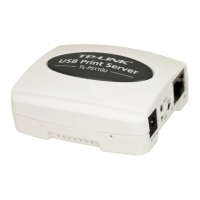
Do you have a question about the TP-Link TL-PS110U and is the answer not in the manual?
| Networking standards | IEEE 802.3, IEEE 802.3u |
|---|---|
| Ethernet LAN data rates | 10, 100 Mbit/s |
| Network connection type | Ethernet LAN |
| Interface | USB 2.0 |
| Network ready | Yes |
| Power requirements | 5V DC, 2A |
| Compatible operating systems | Windows 9x/ME, Windows NT/2000/XP/Vista, Mac OS 8.1 or Later, UNIX/Linux, Netware 3.12 or Later |
| Non-operating relative humidity (non-condensing) | 0 - 80 % |
| USB 2.0 ports quantity | 1 |
| Storage temperature (T-T) | -5 - 65 °C |
| Operating temperature (T-T) | 0 - 50 °C |
| Operating relative humidity (H-H) | 0 - 70 % |
| Certification | FCC, CE |
| Supported network protocols | TCP/IP, IPX/SPX, NetBEUI, Apple Talk, LPR, IPP/SMB, RAW, TCP |
| Internal | No |
| Product color | White |
| Package type | Box |
| Package depth | 168 mm |
| Package width | 207 mm |
| Package height | 68 mm |
| Package weight | 280 g |
| Quantity per pack | 1 pc(s) |
| Windows operating systems supported | Windows 10, Windows 2000, Windows 7, Windows 8, Windows 8.1, Windows ME, Windows NT, Windows Vista, Windows XP |
| Depth | 65 mm |
|---|---|
| Width | 73 mm |
| Height | 30 mm |
Provides an overview of the external print servers' capabilities and network integration.
Lists the physical and functional components of the print server, including ports and indicators.
Explains the meaning of the different LED states on the print server for status indication.
Details the default username, IP address, and subnet mask for the print server.
Lists the necessary items required before starting the hardware installation of the print server.
Provides step-by-step instructions and a diagram for physically connecting the print server to a printer and router.
Guides users through configuring the print server using the PSWizard utility on Windows systems.
Explains how to add the print server to other computers on the network, covering different scenarios.
Details how to access the print server's web management interface by logging in.
View print server status, including system info, printer details, and TCP/IP settings.
Configure general system settings, including system, wireless, and TCP/IP parameters.
Access miscellaneous settings like factory defaults and firmware upgrades.
Provides instructions on how to reboot the print server to apply settings or resolve issues.